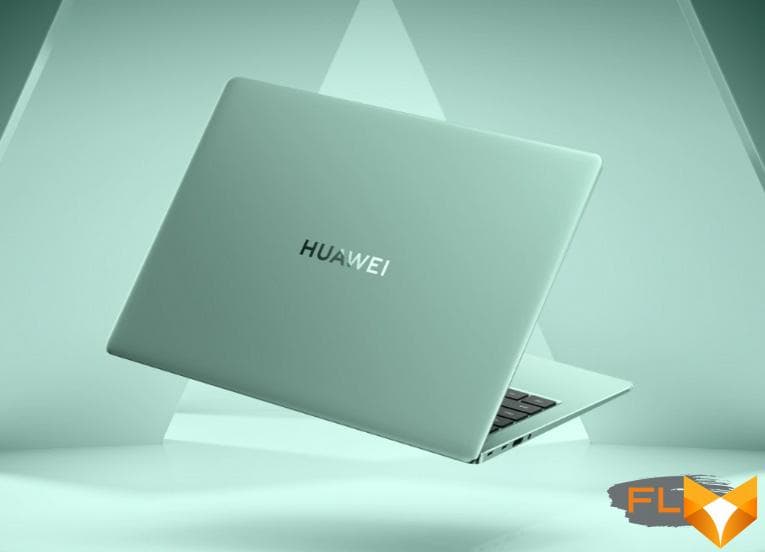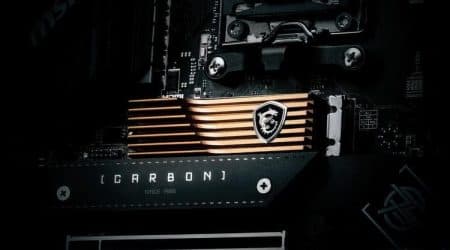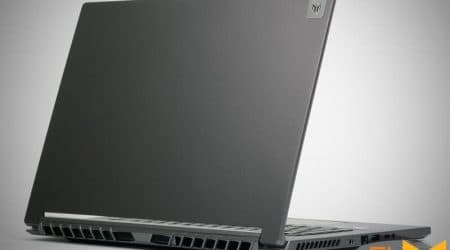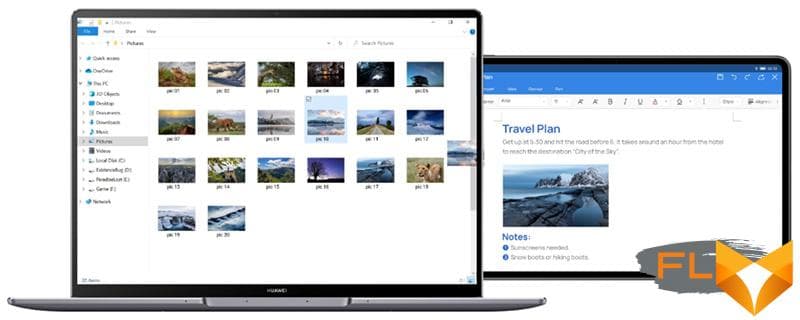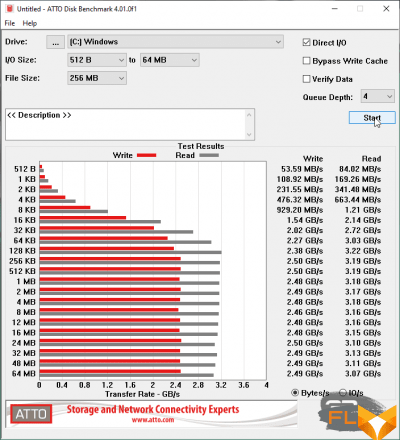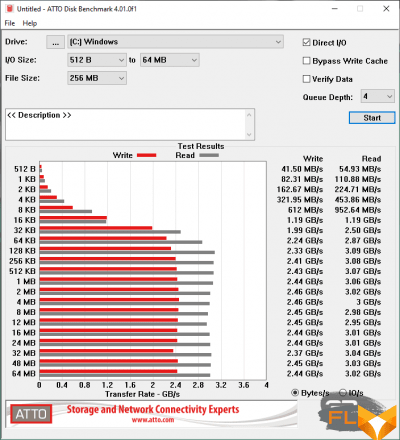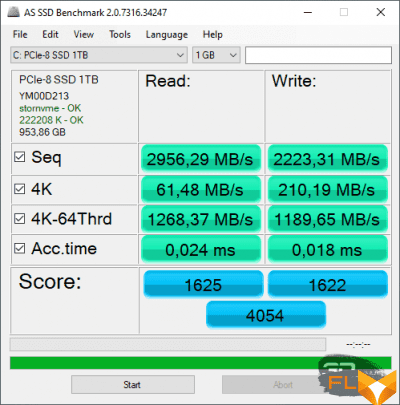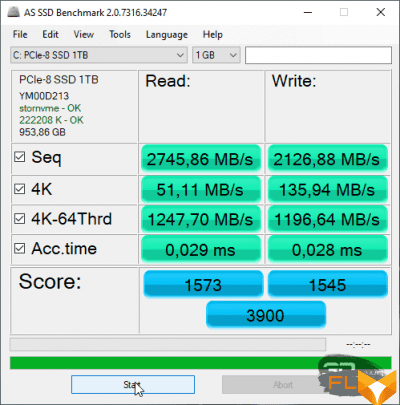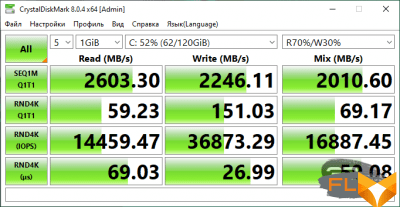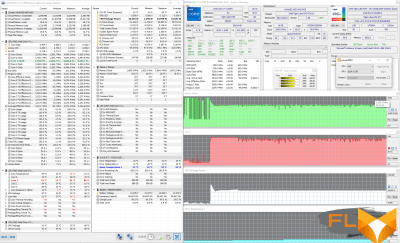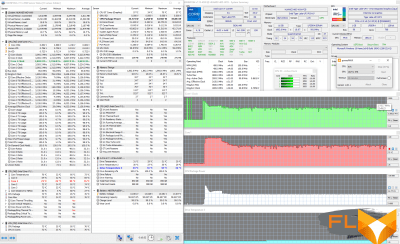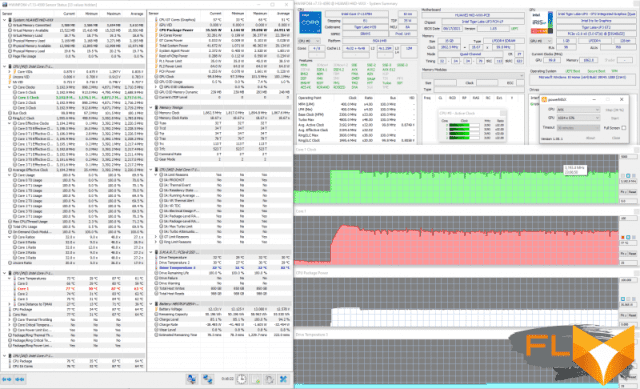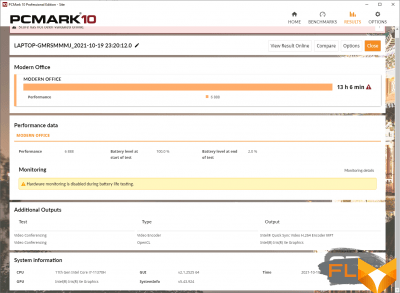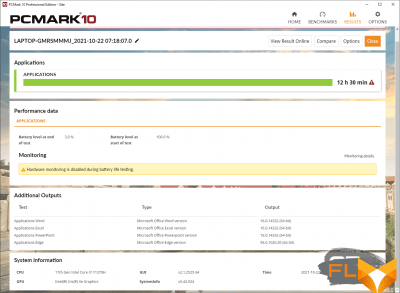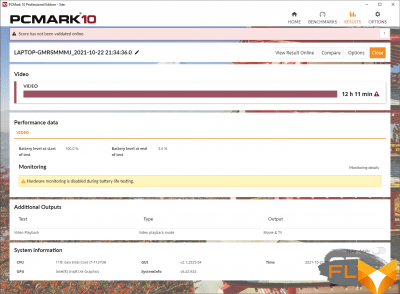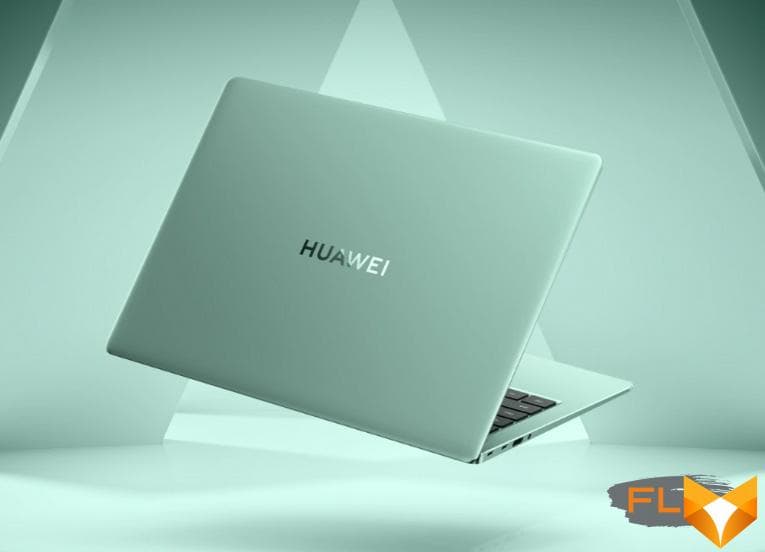


Since October 26 of this year, pre-orders for a new HUAWEI laptop with the laconic name MateBook 14s have been opened for users. The company refers this model to the premium segment of ultra-compact laptops in all key areas: screen, hardware configuration, functionality and design. Indeed, compared to previous HUAWEI models, the new MateBook 14s is a tangible step forward: it has definitely become more interesting, but also, unfortunately, somewhat more expensive. We will tell you about all the features of the new laptop in today’s material.
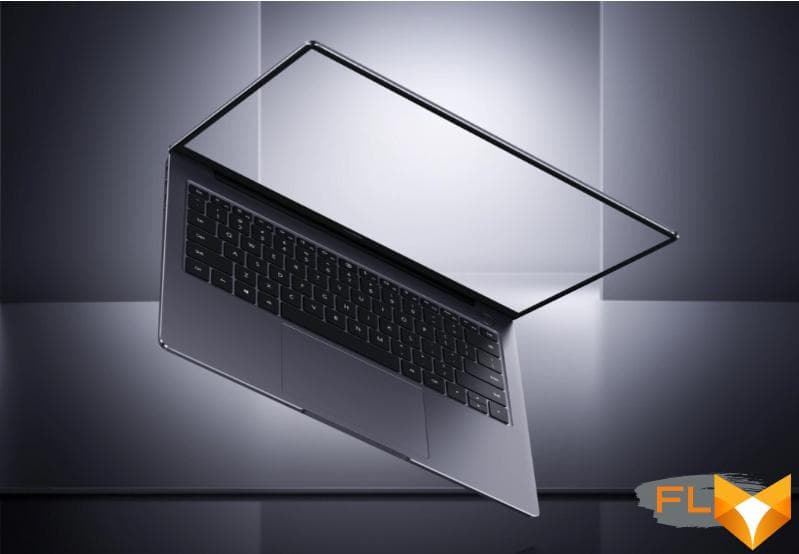
⇡#Box and accessories
HUAWEI MateBook 14s comes in a beautiful white box with a plastic carrying handle. On the front side, the name of the manufacturer and series of the laptop is applied in golden paint, and the HUAWEI logo is in the upper right corner.

It seems to us that with such conciseness and a combination of white and gold colors, the company emphasizes the status of the device sealed in the box, since most of the company’s other laptops are shipped in ordinary red cardboard boxes.
On the sticker at the end of the box are brief characteristics of the laptop, and below, under the barcode, its serial number.
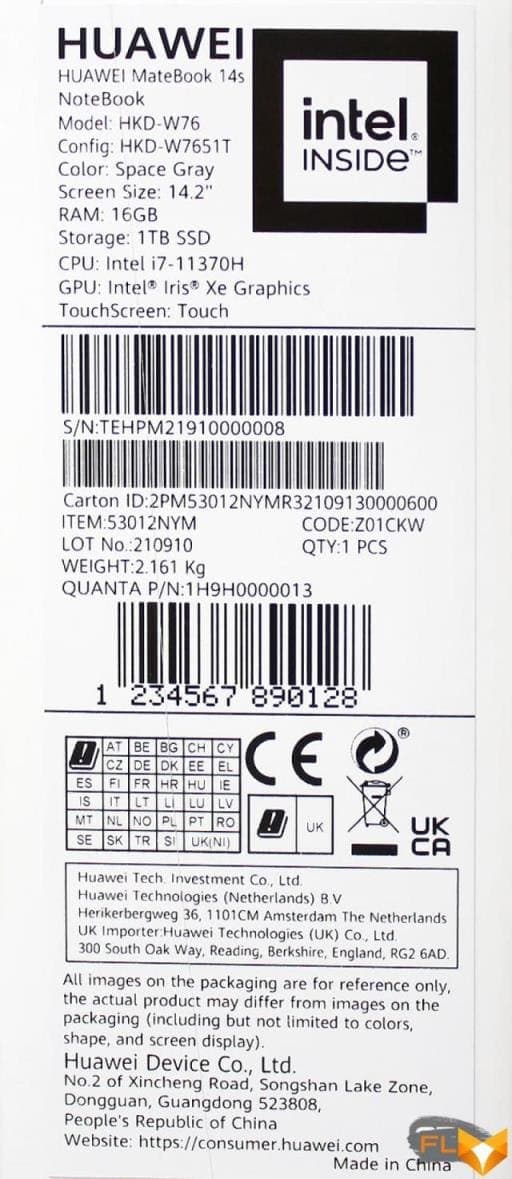
Inside the box, the laptop is securely fixed in two polyethylene foam inserts, and a power adapter with a USB Type-C cable is inserted into a separate compartment on the side.
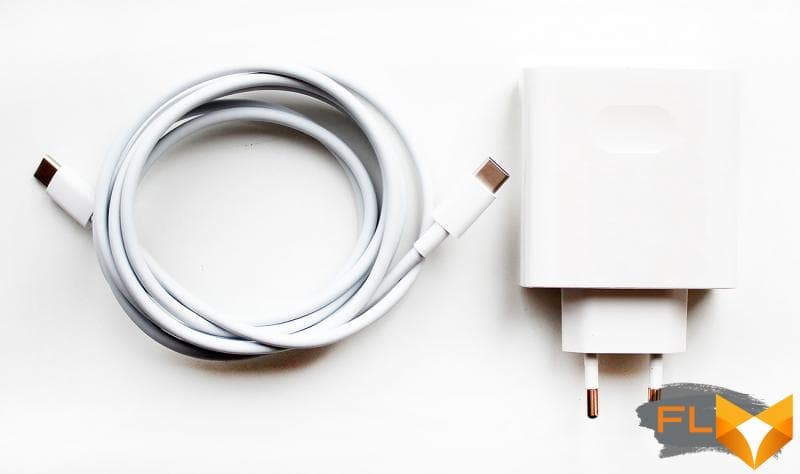
The cost of the new HUAWEI MateBook 14s in the configuration provided to us for testing is $2,100. However, if you pre-order the laptop between October 26 and November 11, you’ll get the MatePad 11 tablet with 128 GB of internal memory, which costs $600 if purchased separately. We add that the laptop is produced in China and is accompanied by a one-year warranty, which can be extended to two or even three years under special HUAWEI programs.
⇡#Specifications
| HUAWEI MateBook 14s (HKD-W7651T) | ||
| CPU | Intel Core i7-11370H (Tiger Lake H35, 10nm SuperFin, 4 cores/8 threads, 3.3-4.8GHz, 12MB L3 cache, 35W max TDP) | |
| Chipset | Intel Tiger Lake-U | |
| RAM | 16 (4 × 4) GB LPDDR4x-4266 GHz (soldered), timings 32-34-34-79 CR1 | |
| Video Subsystem | Intel Iris Xe Integrated Graphics | |
| Accumulator | 1 × SSD 1TB, M.2 2280, NVMe, PCIe 3.0 x4 | |
| Display | 14.2″ LTPS touchscreen, 2520×1680 pixels (3:2 aspect ratio), 90Hz or 60Hz, 400nits brightness, 1500:1 contrast ratio, 213dpi density, 178 viewing angle °; 100% sRGB color gamut; mirror surface with oleophobic coating; TÜV Rheinland certificate | |
| Sound subsystem | Realtek codec, 4 stereo speakers HUAWEI Sound Surround System | |
| Cart Reader | No | |
| Network interfaces | Cable network | No |
| Wi-Fi | Intel Wi-Fi 6 AX201D2W (802.11ax, MIMO 2×2, 2.4 and 5 GHz, 160 MHz) | |
| Bluetooth | Bluetooth 5.2 | |
| Interfaces and Ports | USB | 2 × USB 3.2 Gen1 Type-C, with support for DP Alt Mode, charging and DisplayPort 1 × USB 3.2 Gen1 Type-A |
| Video outputs | HDMI 2.0 | |
| Audio connectors | 1 combo for headset (mini-jack) | |
| Input Devices | Keyboard | Membrane, without numeric keypad, 1.5 mm key travel, two-level backlighting |
| Touchpad | Two-button, dimensions 120 × 72 mm | |
| VoIP | Webcam | 720p@30 FPS embedded in top bezel |
| Microphone | Four microphone array | |
| Battery | Lithium Polymer 60 Wh (5195 mAh) | |
| Power adapter | HW-200450EP0, max. power 90 W (20.0 V, 4.5 A), weight 188 g, cable length 1.76 m and weight 54 g | |
| Dimensions | 314 x 230 x 17.5mm (20.5mm back thickness) | |
| Weight without power adapter: declared/measured | 1430 / 1432 g | |
| Housing colors | “Space Gray” or “Sage Green” | |
| Other Features | Aluminum housing; HUAWEI Share technology (multiscreen); power button with built-in fingerprint scanner; HUAWEI PC Manager; productive or balanced mode of operation | |
| Operating system | Windows 10 Home | |
| Warranty, years | 1 (expandable to 3) | |
| Official cost, $ | 2100 (+ gifts) | |
⇡#Hull design and ergonomics
HUAWEI MateBook 14s is released in a compact metal case and can be designed in two colors with the original names “space gray” and “sage green”. We are testing the first version, but the second version should look even more interesting outwardly.
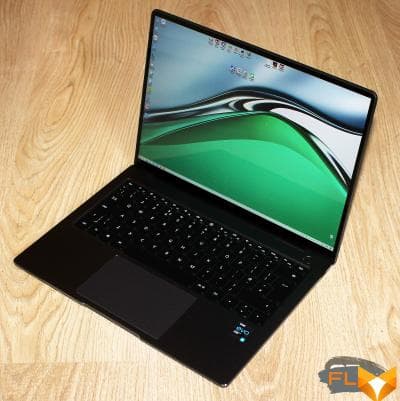 | 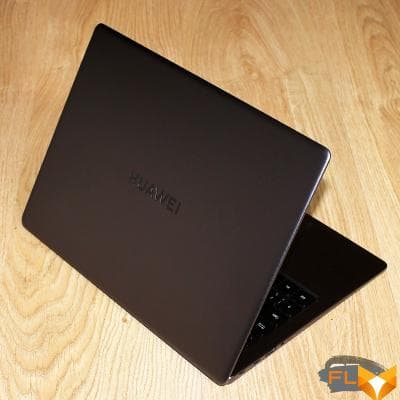 |
The design is concise and calm, without sharp transitions or eye-catching details. Notes of sophistication to the laptop are given by chrome-plated chamfers of the working panel and the so-called frameless screen glass.
In the center of the screen cover there is a single element – the chrome-plated “HUAWEI” inscription. The aluminum panel is completely non-marking, it does not leave fingerprints of clean and dry fingers.
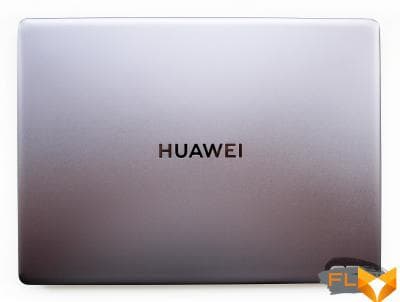 | 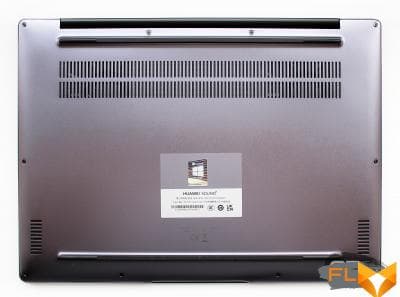 |
On the base there is a ventilation grill and legs made of dense rubber about 3 mm high.

The dimensions of the laptop are 314 × 230 × 17.5 mm (including legs), but the back is thicker – 20.5 mm. But the mass for 14 inches and such dimensions is rather big – 1432 grams, but such is the retribution for the rigid aluminum case.
Also, on the bottom of the case, we highlight two small grilles of the laptop’s acoustic speakers.
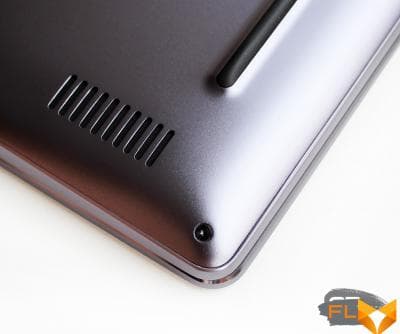 | 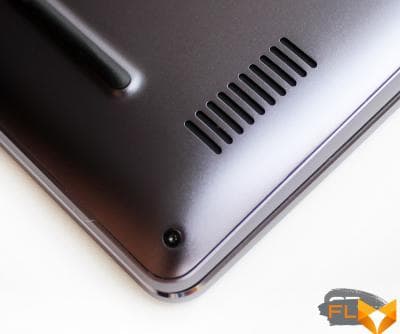 |
In front, we note a recess, thanks to which the lid can be lifted with one hand without holding the base.

Four small dots are built-in microphones that pick up sounds from five meters.
The opposite end is devoid of any ports or connectors, but when the panel with the display is opened at the back, ventilation holes open to remove heated air.

All ports are located on the side ends.
 |  |
On the left are two USB Type-C 3.2 Gen1 with charging support and DisplayPort (Thunderbolt 4 is also supported), HDMI 2.0 video output and a universal mini-jack for microphone / headphones, and on the right there is only one USB 3.2 Gen1 Type-A port.
 | 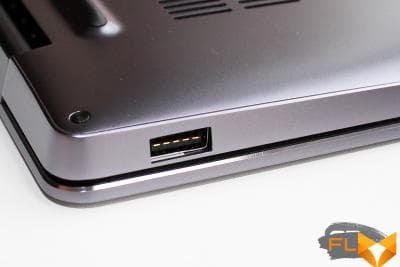 |
In our opinion, it’s somehow not enough for a premium laptop, especially since one Type-C will periodically be busy charging, and a wireless mouse receiver is often plugged into the only Type-A (yes, we remember that mice can also be connected via Bluetooth , but if premium, then why any compromises?). I would like to see at least one more Type-A and a card reader here.
The maximum opening angle of the laptop screen is 150 degrees.

The quality of materials and assembly of HUAWEI MateBook 14s is at a high level. All panels fit tightly to each other, do not creak when pressed, and the panel with the screen, thanks to the aluminum case and the glass surface of the display, is very rigid and does not bend.
⇡#Input Devices
HUAWEI MateBook 14s is equipped with a membrane-type keyboard without a numeric keypad. The dimensions of the main keys are 17 × 17 mm, the function keys are 16 × 9 mm, and the height of the up and down arrows is reduced to 8.0 mm. Reduced arrows require getting used to.
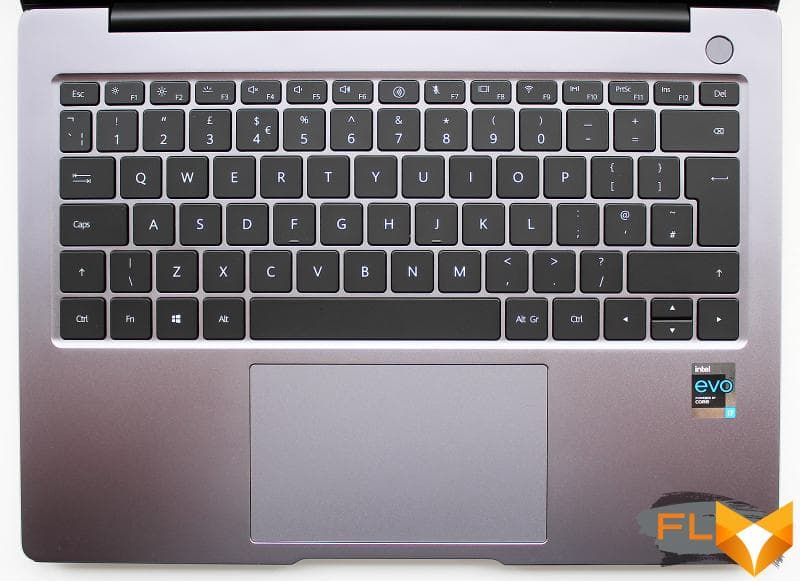
The contact surface of the keys is slightly concave, their stroke is 1.5 mm, the pressing is soft, almost silent. Space, right Shift and Enter are larger, but the left Shift key is exactly the same as the letter keys – it also takes some getting used to.
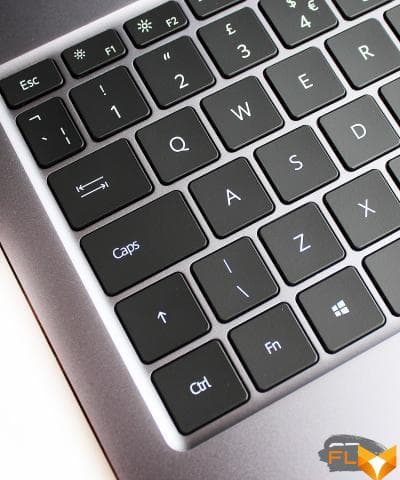 |  |
Our version of the laptop does not yet have a Russian layout, but most likely it will also be printed in white, like the English layout. The keyboard has a soft white backlight with two brightness levels.
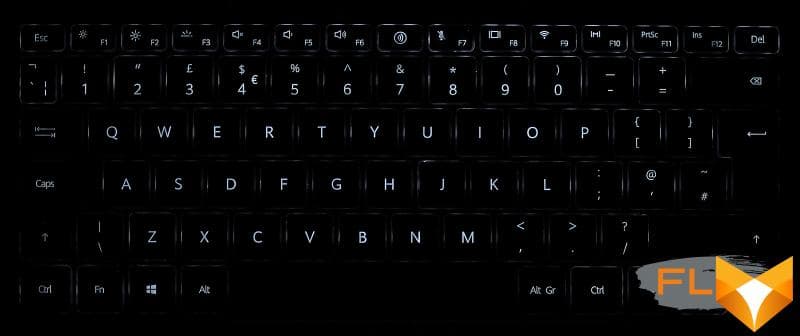
An interesting feature of the keyboard is that in the dark the backlight turns on automatically (only noticed when the power adapter is connected).
The dimensions of the two-button touchpad are 120 × 72 mm. It is convenient to work with it, the surface is smooth, the sensitivity is high, the operation of the buttons is well felt. Supports up to four simultaneous touches.
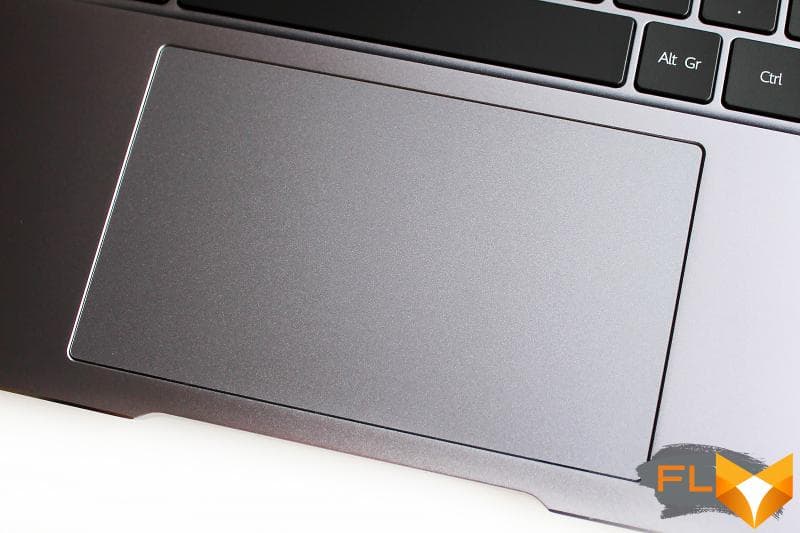
A 720p (30 FPS) webcam is located in the top bezel of the display. It is possible to unlock Windows by recognizing the user’s face.
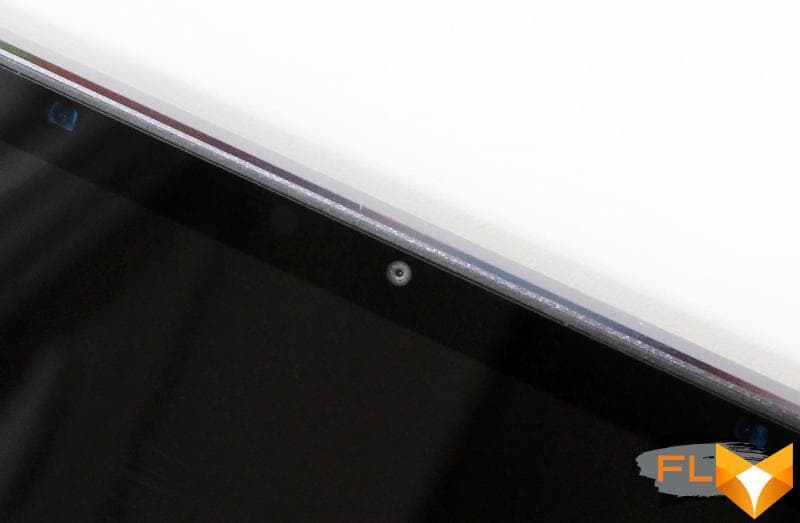
The quality of the camera is average by modern standards, but now it does not hide in a button on the keyboard and does not remove the user’s chin.
The laptop power button is located in the upper right corner, above the Del key.

It has a built-in fingerprint scanner with the ability to store up to 10 fingerprints for each Windows 10 user.
Here you can also highlight the Huawei PC Manager utility, which provides another opportunity to exchange information with a laptop.

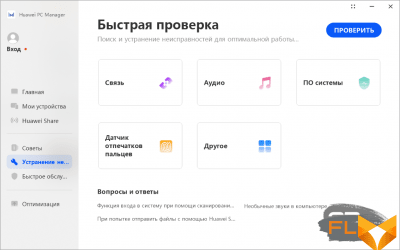 | 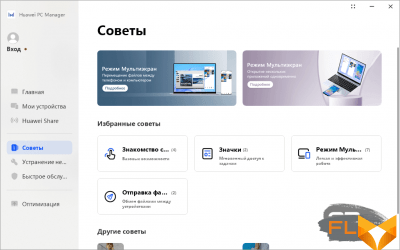 |
Namely, Huawei Share device integration technology, which is well known to users of Huawei products. Only here in the new MateBook 14s, the emphasis is on combining not with a smartphone, but with a tablet (apparently, just with the one that comes as a gift with a laptop). Integration is implemented by the expansion mode, when one image is displayed on the second device, the projection mode (image duplication), and the interaction mode (data and file exchange).
Expansion Mode
Projection Mode
Interaction mode
⇡#Display
The HUAWEI MateBook 14s features a 14.2-inch glossy 3:2 LTPS touch screen with a resolution of 2520 × 1680 pixels. The screen can operate at frequencies of 48, 60 and 90 Hz; increased frequency is new for Huawei laptops. In addition, the brightness is increased to 400 nits, while the 1500:1 contrast ratio and 100% sRGB compliance are maintained at the same level. For comparison, we recall that its predecessor, the MateBook 14 2021 (KLVD-WFE9), was equipped with a screen of the same diagonal with the same aspect ratio of 3:2, but with a more modest resolution of 2160 × 1440 pixels, a frequency of only 60 Hz and a relatively low brightness of 300 nit. That is, a significant step forward is obvious here.
Photo of HUAWEI MateBook 14s laptop screen
The company calls the screen frameless, but physically it has frames: 5 mm on the sides, 7.5 mm on top and 10 mm on the bottom. They are simply covered with glass, which just creates the effect of “framelessness”.
Interestingly, 10-bit color depth is indicated in the display specifications and in the Monitor Asset Manager report.
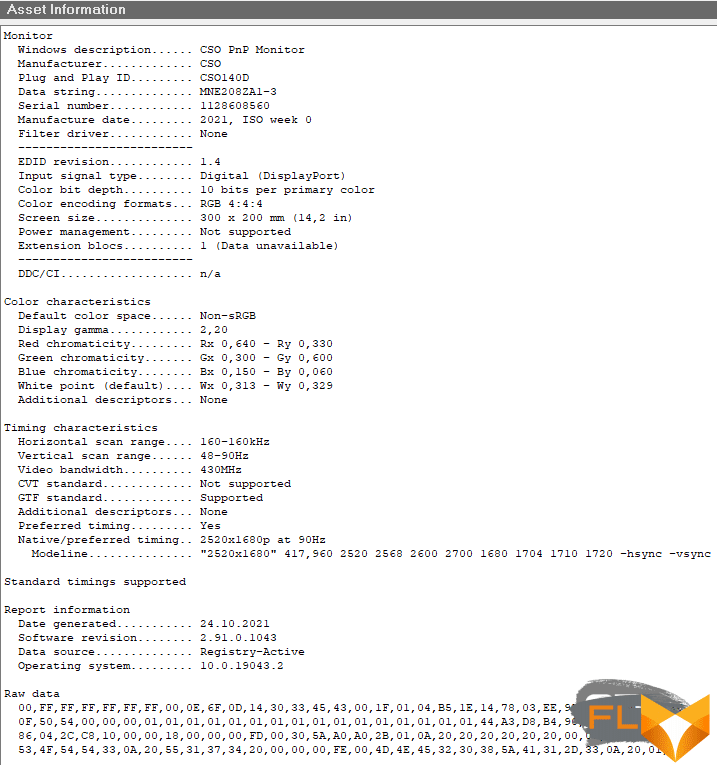
And in the display settings of Windows 10, information is displayed only about the 8-bit matrix.

We tested the laptop display with X-Rite i1 Display Pro and Argyll CMS software with DispcalGUI GUI. All measurements were taken without additional display calibration. Let’s look at

The average DeltaE deviation was 1.1 units, and the maximum was 3.03 units, which is an excellent result.
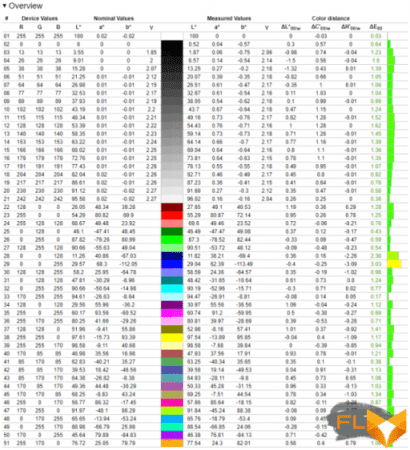
But the color temperature of the display is higher than the reference value of 6500 K and is equal to 6900 K, but it is almost perfectly stable.
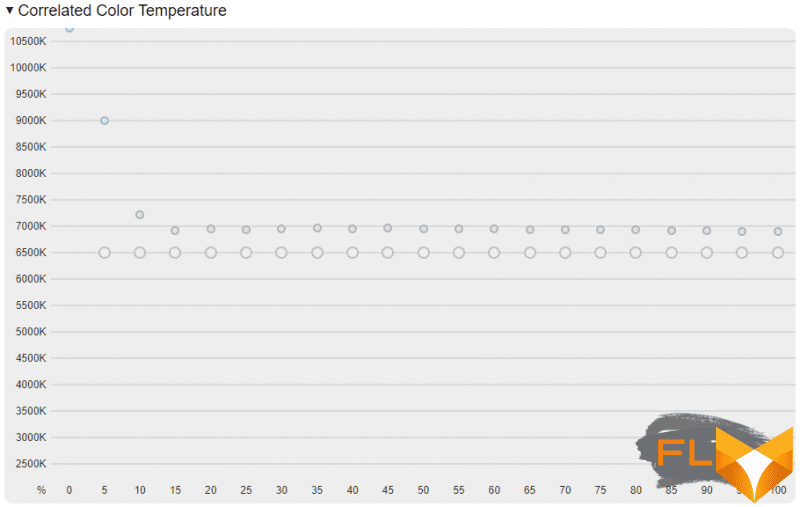
The gamma curve is not perfect, but there are no critical deviations.

But the color balance in the gray gradient display of the HUAWEI MateBook 14s is almost a reference.
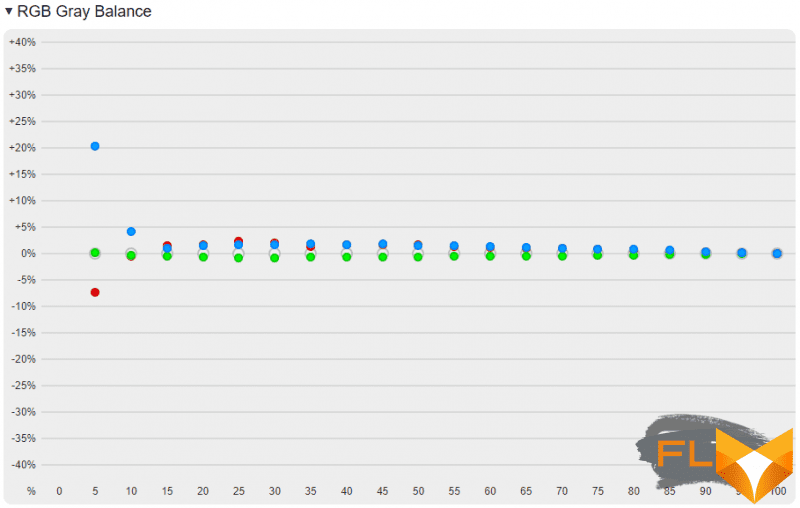
After the calibration, the average deviation level of the DeltaE LTPS matrix of the laptop was only 0.14 units, and the maximum was 0.97. The sRGB color match is 97.6% – not perfect, but very good.

The measured brightness of the display at the maximum level almost corresponds to the nameplate and is equal to 407 cd/m2, and its minimum value is 5 cd/m2.
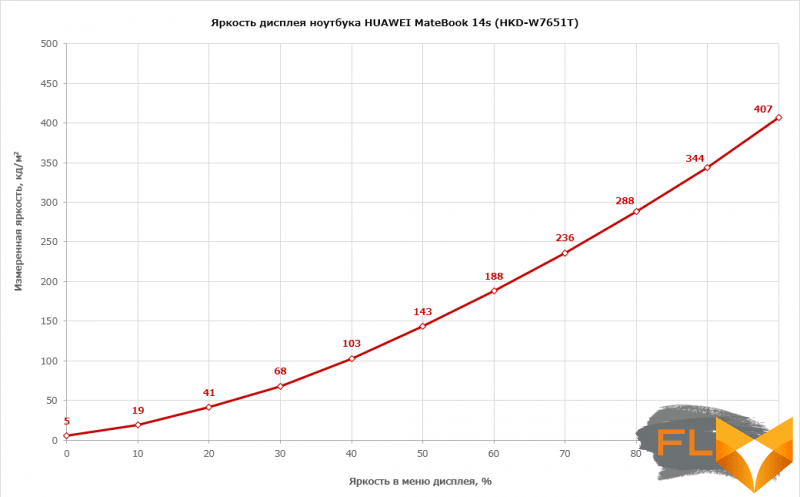
Note that the dependence curve of the brightness of the display from the adjustment in the menu is almost linear, which is convenient for adjustment.
The uniformity of the backlight on the laptop display does not raise questions.

The HUAWEI MateBook 14s screen does not have an anti-glare coating – and this is perhaps its only drawback. Otherwise, according to a subjective assessment, this is the highest quality display, ideal for any task that this laptop can handle.
⇡#Internal device and accessories
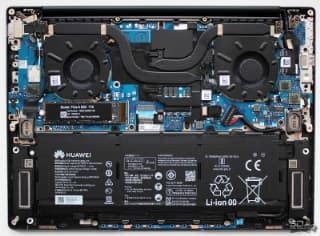 | 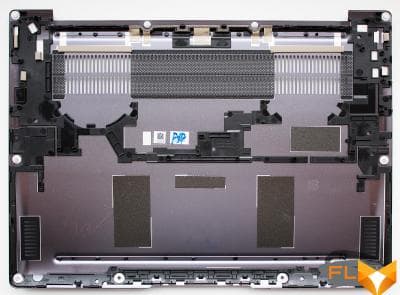 |
A little more than half of the internal volume is reserved for laptop hardware, and the rest is for the battery and acoustics.
We provide a brief summary of the HUAWEI MateBook 14s configuration from AIDA64 Extreme, and then we will analyze each component individually.
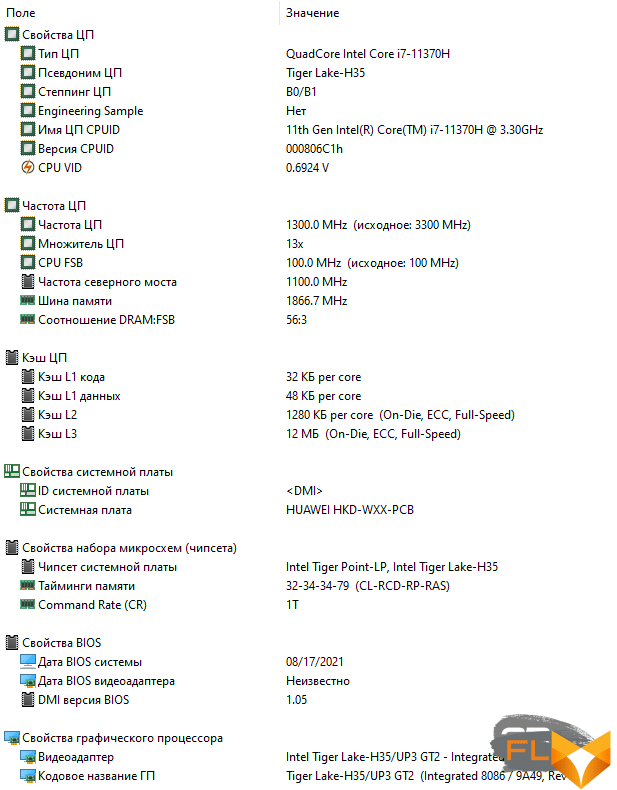
The laptop is based on a Tiger Lake-U chipset with a motherboard with BIOS version 1.05 dated August 17, 2021.
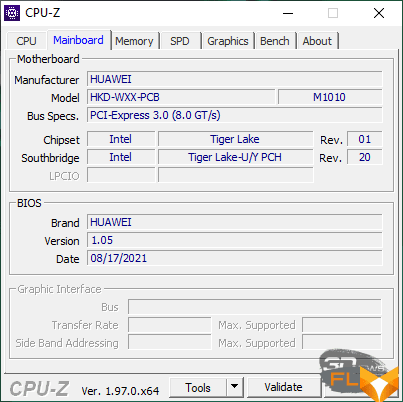
BIOS updates at the time of preparation of the article did not arrive automatically.
Compared to previous HUAWEI MateBook compact laptops, among the first and major changes in the 14s hardware configuration is the new Tiger Lake H35 family of eight-thread Intel Core i7-11370H processor, which differs from Tiger Lake-U with a wider TDP of 35W.
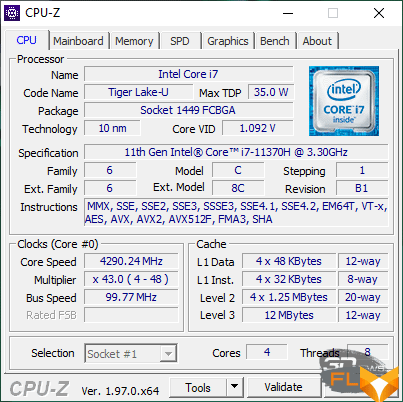
Such a processor is capable of operating at a turbo frequency up to 4.8 GHz and is equipped with a 12 MB third-level cache.
The second major change is faster RAM. If the company’s previous “ultra-compacts” were equipped with 3.2 GHz memory, the new MateBook 14s received 16 GB of LPDDR4x memory, the effective frequency of which is 4.266 GHz, and the primary timings are 32-34-34-79 1T.

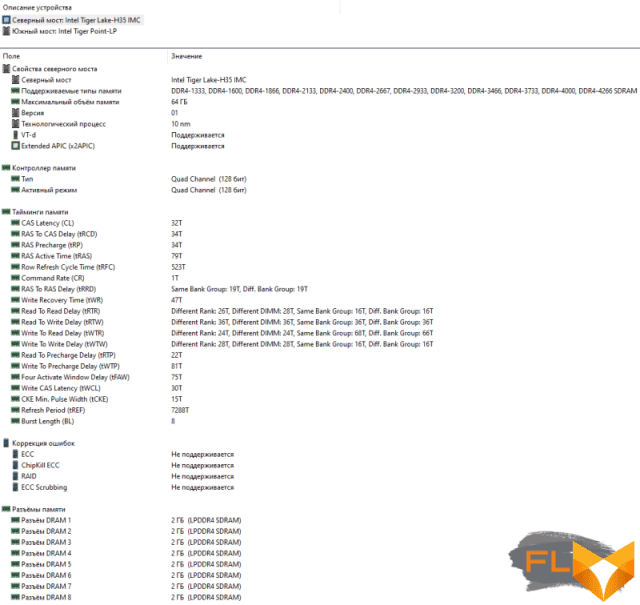
But its bandwidth is strikingly higher than that of the memory of its predecessors. True, latency has also grown, but for non-gaming models, to which the new product belongs, this is a non-critical parameter.
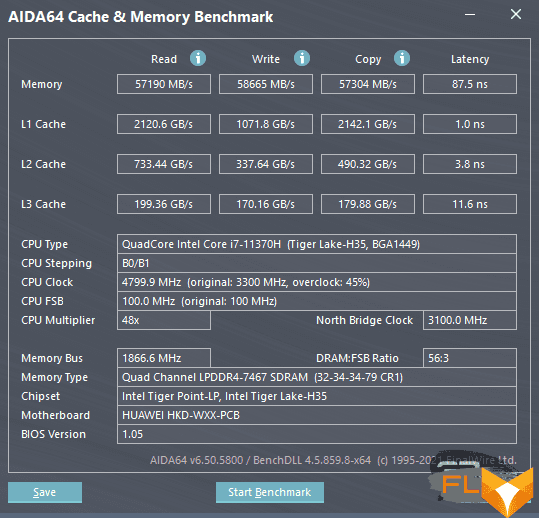
Note that the memory chips are still soldered on the board, so there is no possibility to increase the volume. Yes, and the 32-gigabyte version of the MateBook 14s also does not yet exist.
There is no discrete graphics adapter in the laptop, which is quite logical and predictable in the case of such a compact model. The Intel Iris Xe core, which is quite productive even by modern standards, with 96 execution units and a frequency in 3D mode of 1.35 GHz, is responsible for displaying the picture.
 | 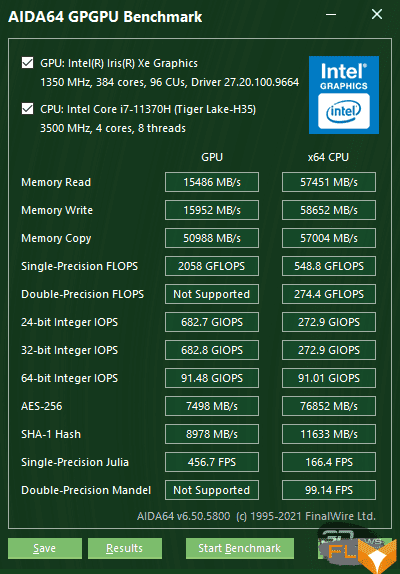 |
Recall that it uses RAM.
The laptop has a single PCIe 3.0 x4 M.2 storage slot with a 1TB SSD (EVO certified). There is a 512GB version of the HUAWEI MateBook 14s that costs $200 less. The original manufacturer of the drive remained behind the scenes, since its name is even more concise than the design of the laptop – PCIe-8 SSD.
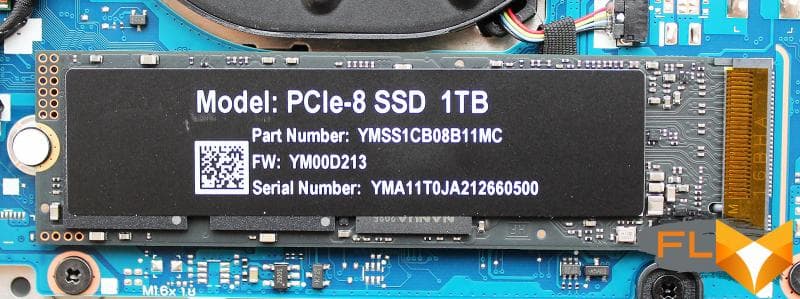
The Crystal Disk Info utility did not expand this information either.
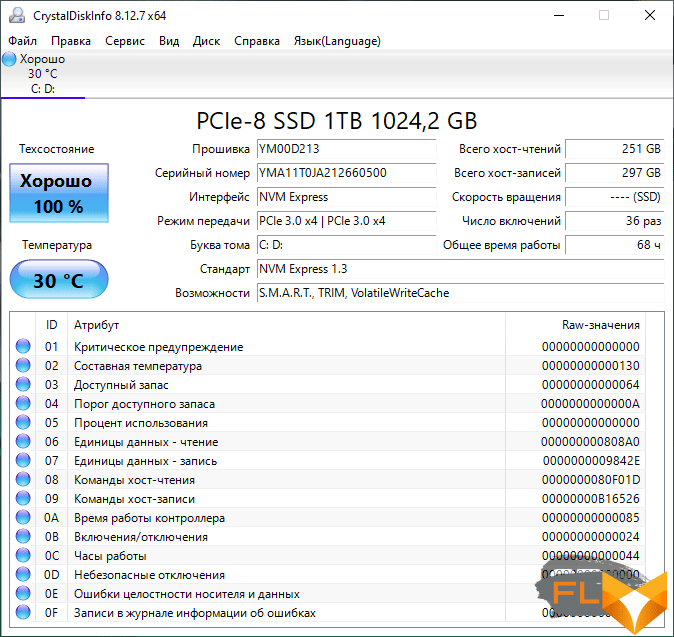
The performance of the drive is at the average level for modern ultrabooks, but according to the results obtained, one can not help but notice that it depends to a minimum extent on the operating mode of the HUAWEI MateBook 14s, that is, it is almost the same when powered either from the power adapter and the mains, or from the battery. The results are shown below in the screenshots.
| ATTO Disk Benchmark (from mains) | ATTO Disk Benchmark (battery powered) |
| AS SSD Benchmark (plugged in) | AS SSD Benchmark (battery powered) |
| CrystalDiskMark (plugged in) | CrystalDiskMark (battery powered) |
As for the temperature regime of the laptop drive, even despite the absence of a radiator, it was not possible to warm it up above 47 degrees Celsius in the stress test.

In everyday work, SSD temperatures do not rise above 38-40 degrees Celsius. For a compact ultrabook, this is an excellent indicator.
HUAWEI MateBook 14s is equipped with an Intel Wi-Fi 6 AX201D2W wireless communication module.
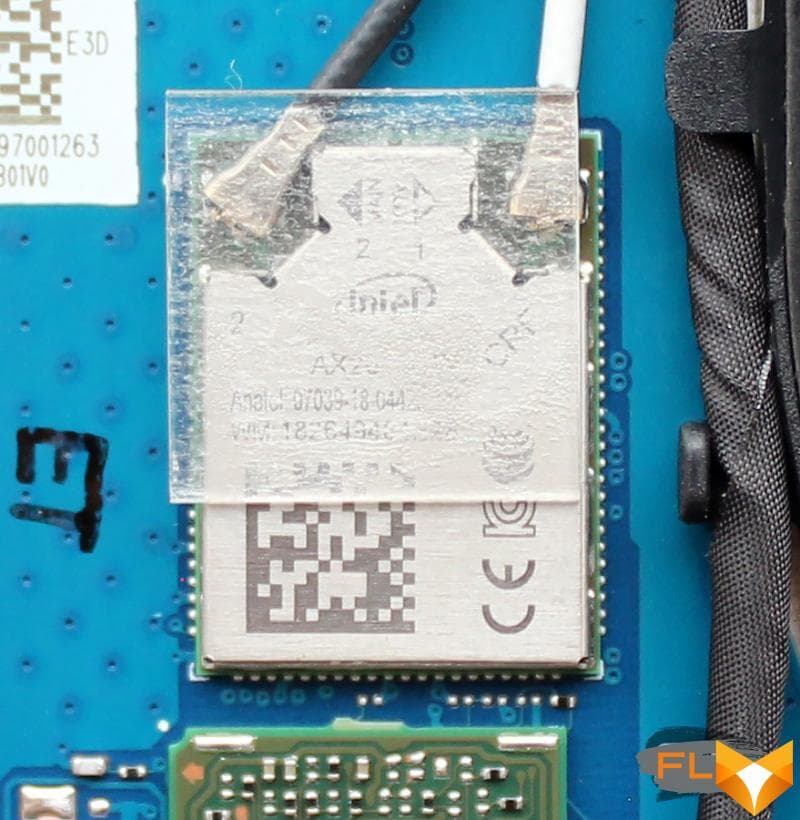
It supports Wi-Fi 6 (802.11ax) and Bluetooth 5.2, MIMO 2×2 protocols, and is also capable of operating at 2.4 and 5.0 GHz (160 MHz bandwidth).
Another distinctive feature of the HUAWEI MateBook 14s is the updated HUAWEI Sound audio system with surround sound. This is achieved through four stereo speakers instead of the standard two.
 |  |
Two are built into the bottom of the laptop case, and two more are directed upwards and output sound through the keyboard.
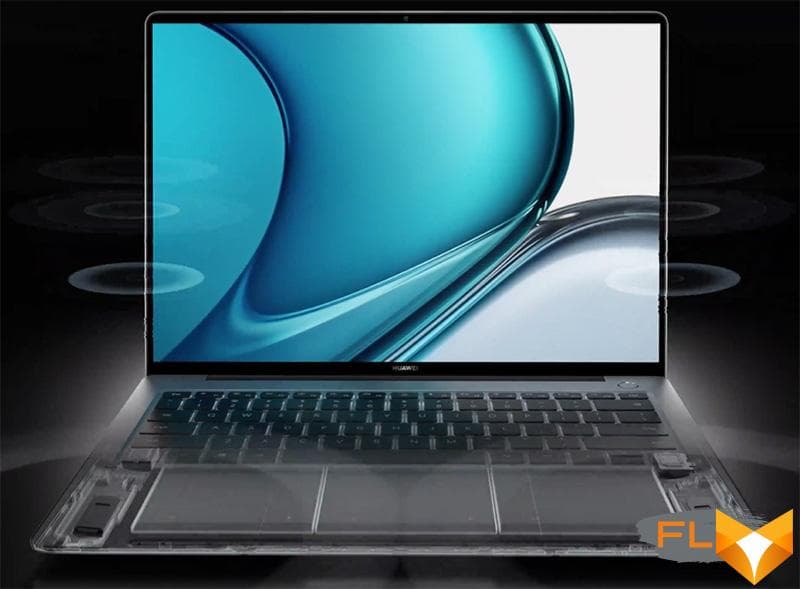
According to a subjective assessment, the sound of the new MateBook 14s is quite good, with a decent volume margin and a detailed drawing of the middle and upper frequency ranges. Low frequencies are traditionally not enough, but where can they come from?
⇡#Cooling system, efficiency and noise level
The increase in the thermal package of the processor forced the developers to reconsider the ultrabook’s cooling system. This is not to say that the previous models were seriously overheating or excessively noisy, nevertheless, the MateBook 14s cooler still needed some work. Judging by what we see, it consisted in increasing the diameter of the heat pipes to 8 mm, increasing the radiators and the diameter of Shark Fin branded fans, which also received more thin curved blades made of high-strength polymer.

Fans suck in cold air from below, through the ventilation grill and throw it out through the holes in the rear end.

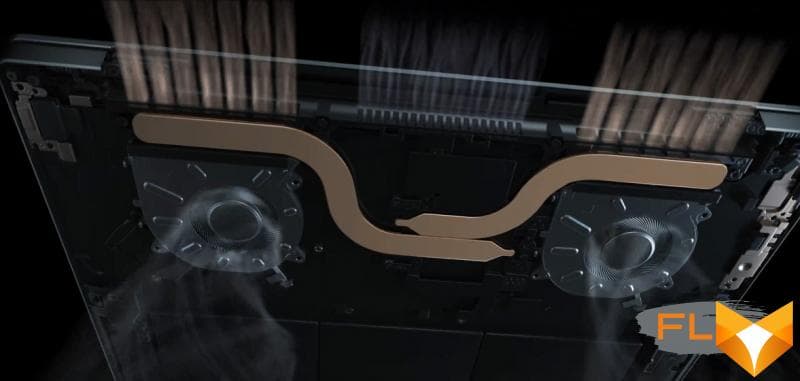
The declared noise level of the cooling system in the daily operation of the laptop should not exceed 25 dBA. In simple terms, it is very quiet.
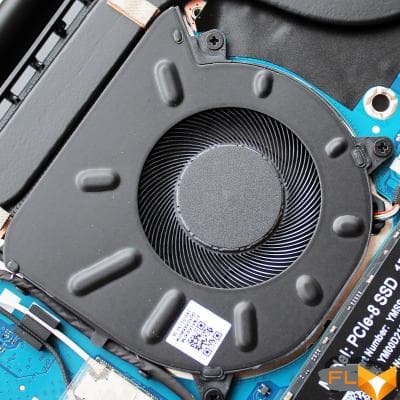 |  |
The ultrabook and the cooling system have two preset operating modes: productive and balanced.

The first is available only when powered by the mains and only if the battery level is at least 20%. The second is always available (except, of course, situations with a dead battery). You can switch between modes either with the Fn + P key combination, or through Huawei PC Manager. We tested the MateBook 14s in both operating modes.
To evaluate the efficiency of CPU cooling in a laptop, we used the powerMAX stress test in AVX mode. The HWiNFO64 utility version 7.13.4590 was responsible for monitoring all indicators. Testing was conducted under the operating system Windows 10 Pro x64 with the latest available drivers and updates. The ambient temperature in the room was 24.5 degrees Celsius.
Let’s look at the results.
| Performance (3.6GHz, 91°C, 45W) | Balanced (3.2GHz, 73°C, 35W) |
The difference between the modes is obvious. In the first case, after a short overheating and throttling, the processor frequency stabilizes at around 3.6 GHz at a temperature of the hottest core of 91 degrees Celsius and a CPU heat dissipation level of 45 watts, which is even higher than the Intel Core i7-11370H specifications. In this mode, under stress, the laptop is audible, but nothing more. It doesn’t even dare to call him uncomfortable. It seems that the developers really managed to find a balance between performance and noise level. As for the second operating mode, the processor frequency in it is approximately 3.2 GHz at a temperature of 73 degrees Celsius and a CPU heat dissipation level of 35 watts. From the cooling system, only a slight rustle is heard, and in the mode without stress load, it works silently.
When the power adapter is disconnected from the laptop, as mentioned above, only the balanced mode is available, in which we received the following stress test result.
Balanced (3.2GHz, 77°C, 36W)
As you can see, the difference with the balanced mode of operation of the MateBook 14s when powered from the mains is noticeable only at the beginning of the test, where the laptop does not immediately increase the frequency and does not allow a jump in temperature with throttling. And with the subsequent stabilization, we received the same indicators as when working from the mains.
⇡#Performance testing
To evaluate the performance of the new HUAWEI MateBook 14s, we included two more laptops with 14-inch screens that we tested earlier in the table of results. The first was the Honor MagicBook 14 NMH-WDQ9BNE with an AMD Ryzen 5 5500U processor, and the second was the HUAWEI MateBook 14 2021 KLVD-WFE9 with an Intel Core i7-1165G7 processor (in fact, this is the predecessor of the hero of today’s test). All laptops were tested in maximum performance mode when running on a power adapter connected to the mains. The results of processor tests and RAM tests are presented in the table.
| Test name | Measure | HUAWEI MateBook 14s HKD-W7651T (Intel Core i7-11370H) | Honor MagicBook 14 NMH-WDQ9BNE (AMD Ryzen 5 5500U) | HUAWEI MateBook 14 2021 KLVD-WFE9 (Intel Core i7-1165G7) | |
| Announcement date and cost: | September 2021 $2100. | September 2021 $1000. | May 2021 $1700. | ||
| AIDA64 Extreme memtest | Read | ↑ | 57 190 | 43 332 | 43 906 |
| Write | ↑ | 58 665 | 39 141 | 43 911 | |
| Copy | ↑ | 57 304 | 34 766 | 36 367 | |
| Latency | ↓ | 87,5 | 95,4 | 75,4 | |
| WinRAR | KB/s | ↑ | 10 906 | 10 437 | 10 808 |
| 7-Zip | GIPS | ↑ | 43 284 | 47 349 | 39 644 |
| HandBrake | H.265 MKV 4K, s | ↓ | 674,11 | 512,70 | 635,69 |
| CineBench R23 | CPU (Multi Core), pts | ↑ | 6 199 | 7 042 | 5 827 |
| CPU (Single Core), pts | ↑ | 1 383 | 1 180 | 1 321 | |
| Blender | Classroom, time | ↓ | 0:19:19 | 0:14:59 | 0:20:52 |
| Geekbench 5 | Single-Core Score | ↑ | 1 550 | 1 095 | 1 555 |
| Multi-Core Score | ↑ | 5 967 | 5 561 | 5 050 | |
| VeraCrypt (Kuznyechik (Serpent (Camellia) | Encryption, MiB/s | ↑ | 488 | 427 | 197 |
| Decryption, MiB/s | ↑ | 458 | 399 | 191 | |
| PCMark’10 | Total | ↑ | 5 402 | 5 100 | 5 029 |
| Essentials | ↑ | 10 689 | 8 962 | 10 070 | |
| Productivity | ↑ | 7 078 | 7 605 | 6 642 | |
| Digital Content Creation | ↑ | 5 656 | 5 281 | 5 163 | |
| 3DMark | Night Raid | ↑ | 18 360 | 12 801 | 13 234 |
| Fire Strike | ↑ | 5 114 | 2 935 | 3 580 | |
| Wild Life | ↑ | 13 346 | 5 931 | 8 373 | |
| World of Tanks enCore RT (Full HD, среднее quality) | FHD, Score | ↑ | 11 966 | 10 982 | 9 218 |
The single-threaded performance of the MateBook 14s is simply too high for an ultrabook, so it’s not surprising that it leads in all of these tests. But in a multi-threaded load, the leadership belongs to the Honor MagicBook 14 with an AMD Ryzen 5 5500U processor – it’s hard to oppose it here. But in gaming performance, the integrated graphics core Intel Iris Xe is unmatched. In addition, we will provide screenshots of the results in 3D benchmarks, which contain a lot of useful information.
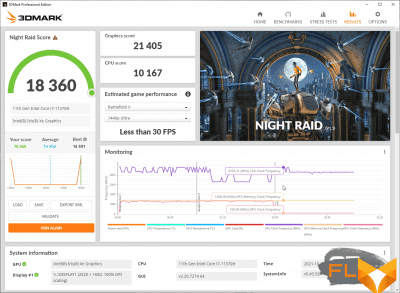 | 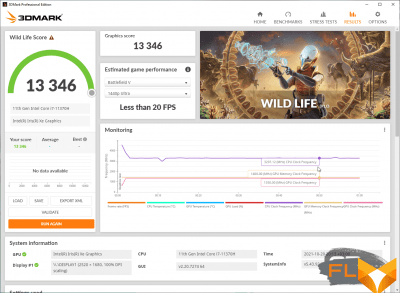 |
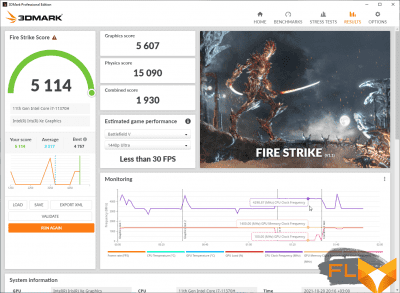 | 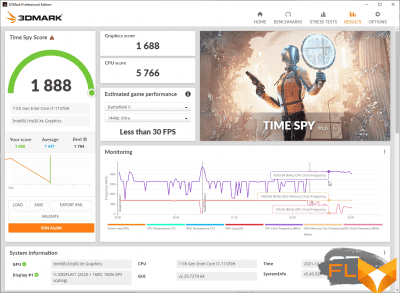 |

⇡#Autonomous
The capacity of the lithium-polymer battery in HUAWEI MateBook 14s is 60 Wh (5195 mAh).

According to AIDA64 Extreme, the capacity when fully charged turned out to be slightly lower than the passport, but within the tolerances (less than 0.7% difference).
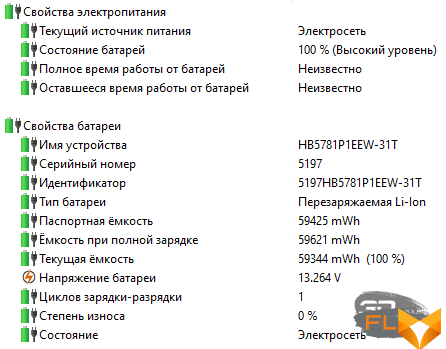
Compared to previous MateBook models, another innovation of the new 14s is the increased power adapter. If the company’s previous ultrabooks were equipped with an adapter with a maximum power of 60-65 watts, then a 90-watt adapter is included with the new ultrabook (model HW-200450EP0 weighing 188 grams).

This allowed the company to declare the possibility of express charging MateBook 14s, when in just 15 minutes of connecting to the power adapter, the laptop is charged for 3 hours of battery life. The laptop battery really gains the first 50% charge very quickly – in just 37-40 minutes, and a full charge cycle from 3 to 100% takes 1 hour 25 minutes (the average result of four cycles).
The autonomy of the ultrabook was tested with a display brightness of 200 cd/m2. Testing was carried out using the PCMark’10 package in four modes. Network connections and sound were not turned off, no artificial optimizations were introduced, the display frequency was 90 Hz, although at 60 Hz autonomy should theoretically increase even more. The results are as follows.
| PCMark’10 Modern Office (13h 6m) | PCMark’10 Gaming (2h 4m) |
| PCMark’10 Applications (12h30) | PCMark’10 Video (12h11) |
If we draw parallels with the same with the MateBook 14 (KLVD-WFE9) with an Intel Core i7-1165G7 processor, the new MateBook 14s has clearly added autonomy. Against the previous 9-11 hours in everyday work emulation, now the ultrabook is able to last 12-13 hours – and this is at a higher resolution and screen frequency. Only the game mode has not changed in time, but everything is clear with it, because the graphics core was practically not modified (+50 MHz in GPU frequency does not count) and works a little faster only due to RAM. Summarizing the autonomy tests of the new HUAWEI MateBook 14s, we can say that a full charge of its battery is enough for the whole working day, even for notorious workaholics.
⇡#Video
⇡#Conclusion
HUAWEI MateBook 14s has really become better than the company’s previous ultrabook models in many ways. First of all, we note a better touch screen with a resolution of 2.5K, a frequency of 90 Hz and a maximum brightness increased to 400 nits. The hardware platform is faster with a more advanced Tiger Lake H35 processor and faster LPDDR4x RAM. Moreover, at the same time, the autonomy of the laptop has increased (on average by a couple of hours), which is important, and thanks to a more powerful adapter, the time to fully charge the battery now does not exceed one and a half hours. The audio system now has four speakers compared to the previous two, and the webcam has been moved from a button to a more familiar top frame, which eliminated strange angles.
Along with the above improvements, the laptop retained the advantages of its predecessors, such as compactness, aesthetic aluminum case, comfortable operation in terms of noise level, large and convenient touchpad, fingerprint scanner, HUAWEI Share integration system with other mobile devices, and more.
At the same time, it cannot be said that the MateBook 14s is completely devoid of flaws. Unfortunately, in this series there is still no version with 32 GB of RAM, there are not enough USB ports and a card reader, and all the same small arrow keys cause inconvenience to the user. It would also be great to see a network adapter with Wi-Fi 6E support in a premium ultrabook, but I would not want to see a rise in cost, on the contrary. However, at the beginning of sales, the MateBook 14s comes with an expensive tablet, so at first it will be extremely difficult for competitors to beat such an advantageous offer.
FAQ Huawei matebook 14s ultrabook review
How does the Huawei MateBook 14s perform in terms of processing power?
The Huawei MateBook 14s, with its Core i7 processor and 16GB of RAM, delivers robust processing power, making it well-suited for tasks like video editing and multitasking.
What are the standout features of the Huawei MateBook 14s according to reviews?
Reviews of the Huawei MateBook 14s highlight its 90Hz refresh rate display, sleek spruce green chassis, Intel Iris Xe graphics, and excellent build quality as standout features.
How does the Huawei MateBook 14s compare to the MateBook X Pro?
Compared to the MateBook X Pro, the Huawei MateBook 14s offers a higher refresh rate of 90Hz, and often comes with newer Intel Core i7 processors, making it a strong contender in Huawei’s laptop lineup.
Is the Huawei MateBook 14s considered among the best laptops for its spec?
Given its high-end Core i7 processor, 16GB of RAM, and Iris Xe graphics, the Huawei MateBook 14s is often considered among the best laptops in its range, especially for users looking for a Windows laptop with a balance of performance and portability.
What type of graphics card is included in the Huawei MateBook 14s?
The Huawei MateBook 14s includes the Intel Iris Xe Graphics card, providing sufficient graphical performance for everyday tasks and some light gaming.
How many USB-C ports does the MateBook 14s have, and what are their functionalities?
The MateBook 14s comes with two USB-C ports, which support data transfer, charging, and connection to external displays, adding to its versatility.
Can the Huawei MateBook 14s be a suitable alternative to a MacBook for Windows 11 users?
Yes, the Huawei MateBook 14s can be a suitable alternative to a MacBook for users who prefer Windows 11, as it offers comparable build quality, performance, and aesthetics.
What are the audio connectivity options available on the Huawei MateBook 14s?
The MateBook 14s provides audio connectivity options like a 3.5mm audio jack, allowing users to connect headphones or external speakers easily.
Is the MateBook 14s’ display surrounded by slim bezels?
Yes, the MateBook 14s’ display is surrounded by slim bezels, contributing to a modern and sleek aesthetic, and maximizing screen real estate.
How does the MateBook 14s integrate with other Huawei devices, like the Huawei smartphone?
The MateBook 14s integrates well with other Huawei devices, like Huawei smartphones, offering features like multi-screen collaboration and file sharing, making it an excellent choice for users invested in the Huawei ecosystem.
